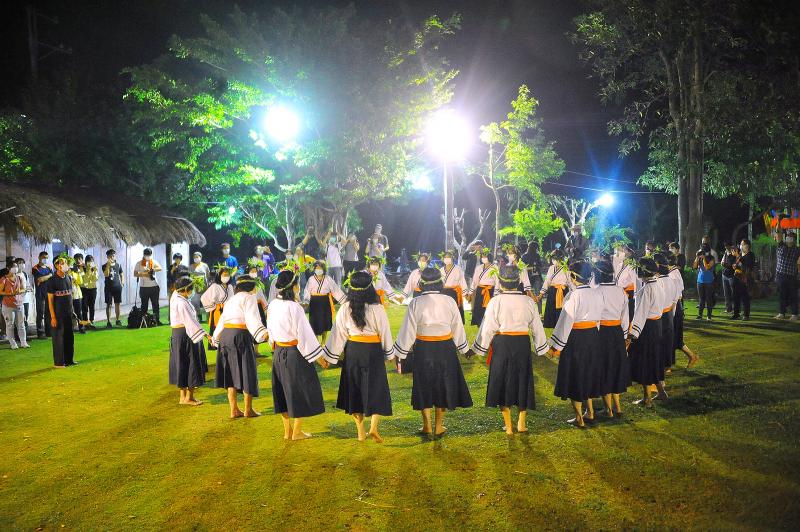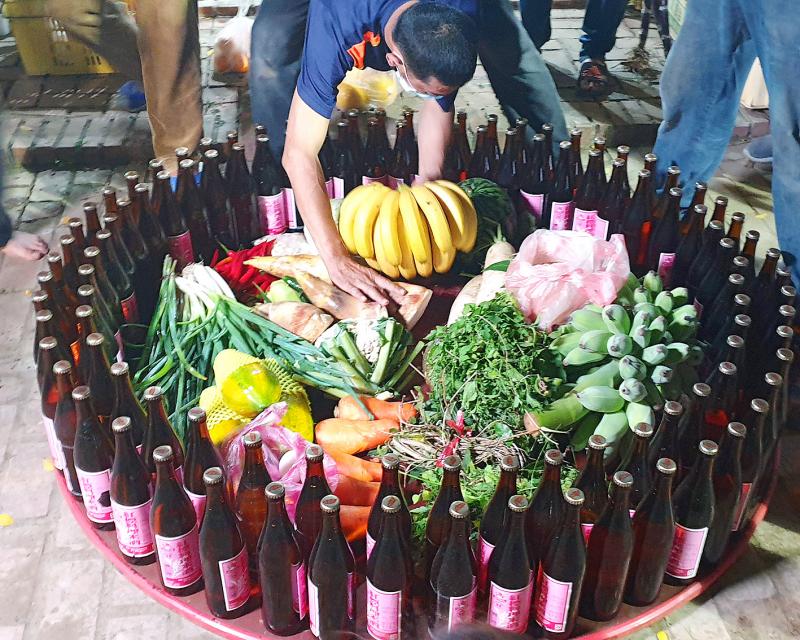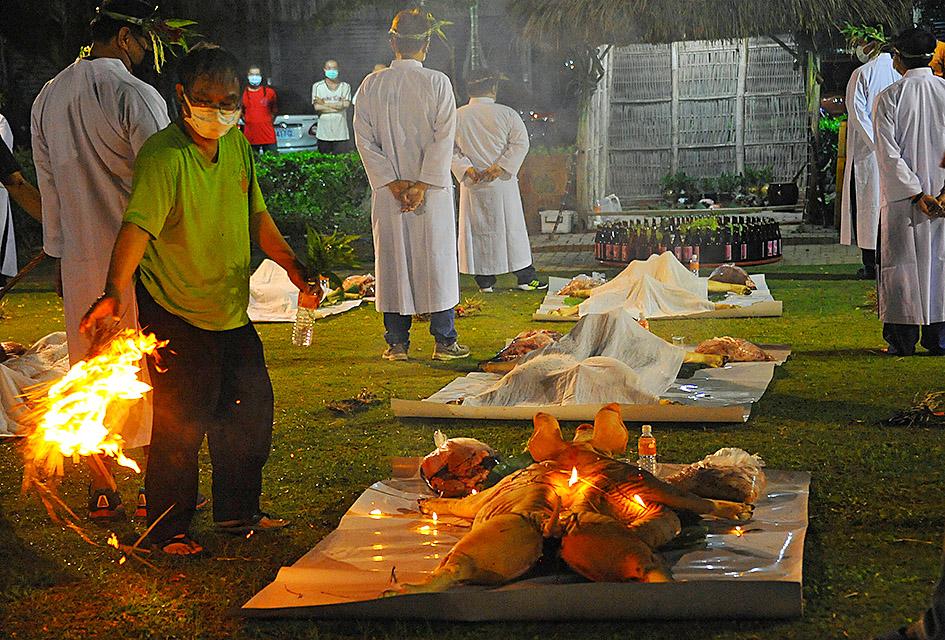Huang Jung-fong (黃榮豐) is trembling on the ground, making retching sounds while clutching a ceremonial staff. He gets up, raises his arms to the sky and walks toward a group of white-robed villagers, delivering divine instructions that kick off the Pataran community’s annual Night Ceremony (夜祭).
Traditionally, a female shaman called an angi (尪姨) would perform the rituals, but Pataran hasn’t had one for as long as its residents can remember. In fact, before Pataran revived its Night Ceremony in 1999, its residents had lost their identity as indigenous Siraya along with most of their original language and culture, save for one thing: the worship of Alid, their collective ancestral spirit. Instead of a statue, Alid is represented with ceramic urns filled with sacred water.
“My grandparents never mentioned anything related to Siraya,” says Yang Chun-sheng (楊俊陞), head of the Tainan City Soulang Pataran Community Development Association. “But they often reminded me to celebrate Alid’s birthday on the 29th day of the third lunar month. Nobody really knew the significance of it.”

Photo: Han Cheung, Taipei Times
Alid’s birthday fell on Tuesday of last week. Starting at dawn, people from surrounding villages made their way to Pataran’s Cingchang Temple (慶長宮), a typical Taoist establishment, paying tribute to Guanyin and other deities from the Han Taiwanese pantheon before bringing three ritual items — betel nuts, rice wine and glutinous rice cakes — to the shrine dedicated to Alid in the back.
Being the only preserved link to their ancestral culture, Alid worship remains the focal point of Pataran’s quest over the past two decades to reclaim their identity, beginning with the revival of the Night Ceremony the night before Alid’s birthday.
During this year’s event, which was significantly pared down due to the COVID-19 pandemic, participants spoke of their reverence for Alid and their ongoing efforts to understand what it means to be Siraya.

Photo: Han Cheung, Taipei Times
“We worship Taoist deities here too, but since I was young I have felt that it was Alid who watched over me, and later over my children. Only after I started working did we find out that we were Siraya,” says Yang Yu-chen (楊玉真). “I started learning about my identity bit by bit, and whenever I have time I’ll try to learn more.”
CULTURAL LOSS
In the old days, Pataran was the center of the Siraya territory of Soulang, one of the ethnic group’s four major settlements on the Tainan plain. Being closest to the ocean, the Siraya of Soulang encountered the Dutch as early as 1623 — a year before they established a colony to the south. Han Chinese settlers soon started arriving en masse, mixing with the local population as well as encroaching on their land.

Photo: Han Cheung, Taipei Times
While Taoism was allegedly brought to Pataran by a Han Chinese immigrant who married into a local family, villagers continued to worship Alid at home and in a number of private shrines. In 1946, a spirit medium relayed a divine message to move all the urns to the current location, which became today’s Lichang Temple (立長宮) in 1955.
Superficially it resembles a concrete Han Chinese shrine, but in place of the figurine there is a tablet inscribed with the Chinese transliteration of Alid (阿立祖) and about 20 urns of different shapes, sizes and styles.
A Chinese couplet adorns the entrance: “A bite of betel nut to worship Alid, a thousand pots of aged wine to remember our ancestors.”

Photo: Han Cheung, Taipei Times
Cingchang temple was added in 1971 for Taoist deities after obtaining Alid’s permission. After 1999, a Siraya-language sign was attached to the entrance: kuva ki Alid (shrine for Alid).
The cultural erosion in Pataran was more severe than the other four Siraya villages that still perform the Night Ceremony, all of which lie in less coveted territory closer to the Central Mountain Range, and thus were subject to less outside influence.
The village of Kabuasua was originally settled by Pataran villagers who migrated due to Han Chinese encroachment. According to Siraya activist Alak Akatuang, they rarely intermarried with Han Chinese and preserved more Siraya culture, although they kept it hidden until the late 1990s when they began to revive their culture and seek official recognition.
The wave of cultural reawakening spread to Pataran, who sent villagers to Kabuasua to learn about the ancestral ways that they had lost. However, the Siraya remain unrecognized by the central government, only gaining recognition from the Tainan County Government (today’s Tainan City Government) in 2005.
‘INTERIM SHAMAN’
Although he has fond memories of the times when Alid’s birthday was a grand affair, Huang never heard of the term Siraya until around 1999. As he greets guests from other Siraya communities before the Night Ceremony, he laments that the local population is dwindling as young people leave for the cities. Few return for the festivities since it often falls on a weekday.
When the Night Ceremony was first revived, the Pataran community enlisted the help of the angi from Kabuasua. Huang’s father, a Taoist spirit medium, became the interim shaman after he allegedly became possessed during a ceremony and started mimicking the angi’s movements. After he suffered a stroke, Pataran asked Kabuasua for help again until Huang assumed the role in 2009.
“Alid sought me out,” he says.
Each village’s event varies, and sometimes even the deity is different. Kabuasua, for example, worships a female Alid, while Pataran’s is male.
The two components of Pataran’s Night Ceremony is the pig sacrifice and qianqu (牽曲), where female dancers link hands, sing and move in a circle around a large urn.
QUEST FOR IDENTITY
Yuko, one of the few Pataran residents to take up a Siraya name, is old enough to remember when they were still seen as a different people from their neighbors. Children from other villages often taunted him as huana (番仔), a derogatory term in Hoklo that means savage or barbarian.
“I got into so many fights because of that,” he says. “But I was mad just because they made fun of me. I had no idea that it had anything to do with our identity.”
By the time Yang Yu-chen grew up, in the 1970s, he says that he never felt any difference between him and his Han Taiwanese neighbors — except that his family worshipped Alid in addition to Guanyin.
In addition to encroachment and assimilation, many Siraya from the Pataran community hid their identity in the past to avoid discrimination.
Huang Mei-li (黃美麗) says that her husband comes from a merchant family who passed themselves off as Hoklo during the Japanese-era census for business purposes, and while her mother comes from a historically Siraya village, they never discussed their ancestry.
Yuko estimates that about one-third of Pataran’s residents were registered under the Japanese-era census as shou (熟), meaning “civilized” indigenes, as opposed to 80 percent in Kabuasua.
Despite the uncertainty, Huang was the first Pataran resident to learn the qianqu dance from Kabuasua village. She also picked up Siraya-style cross-stitch embroidery to decorate ceremonial clothes and other items. Her bag is adorned with a traditional pattern she found from the National Museum of Taiwan History, in addition to the word tabe, which means “hello” in Siraya.
Just two decades into the revival process, the villagers seem to still be figuring out what it means to be Siraya. Yuko says that out of the shrinking population, only about half are interested in further exploring their identity.
During conversations with the villagers, questions about Siraya identity seem to always lead back to Alid. Yang Chun-sheng, for example, was driven by the many extraordinary “miracles” that he attributes to Alid after he moved back in 2003.
“My children are studying in other cities, but whenever they come back I take them to the shrine to pray to Alid,” Yang Yu-chen says. “They are also quite passionate toward Alid. I hope that if they end up working in the south, they can become more involved.”

This month the government ordered a one-year block of Xiaohongshu (小紅書) or Rednote, a Chinese social media platform with more than 3 million users in Taiwan. The government pointed to widespread fraud activity on the platform, along with cybersecurity failures. Officials said that they had reached out to the company and asked it to change. However, they received no response. The pro-China parties, the Chinese Nationalist Party (KMT) and Taiwan People’s Party (TPP), immediately swung into action, denouncing the ban as an attack on free speech. This “free speech” claim was then echoed by the People’s Republic of China (PRC),

Exceptions to the rule are sometimes revealing. For a brief few years, there was an emerging ideological split between the Democratic Progressive Party (DPP) and Chinese Nationalist Party (KMT) that appeared to be pushing the DPP in a direction that would be considered more liberal, and the KMT more conservative. In the previous column, “The KMT-DPP’s bureaucrat-led developmental state” (Dec. 11, page 12), we examined how Taiwan’s democratic system developed, and how both the two main parties largely accepted a similar consensus on how Taiwan should be run domestically and did not split along the left-right lines more familiar in

Specialty sandwiches loaded with the contents of an entire charcuterie board, overflowing with sauces, creams and all manner of creative add-ons, is perhaps one of the biggest global food trends of this year. From London to New York, lines form down the block for mortadella, burrata, pistachio and more stuffed between slices of fresh sourdough, rye or focaccia. To try the trend in Taipei, Munchies Mafia is for sure the spot — could this be the best sandwich in town? Carlos from Spain and Sergio from Mexico opened this spot just seven months ago. The two met working in the

Many people in Taiwan first learned about universal basic income (UBI) — the idea that the government should provide regular, no-strings-attached payments to each citizen — in 2019. While seeking the Democratic nomination for the 2020 US presidential election, Andrew Yang, a politician of Taiwanese descent, said that, if elected, he’d institute a UBI of US$1,000 per month to “get the economic boot off of people’s throats, allowing them to lift their heads up, breathe, and get excited for the future.” His campaign petered out, but the concept of UBI hasn’t gone away. Throughout the industrialized world, there are fears that